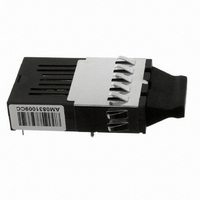AFBR-53D5EZ Avago Technologies US Inc., AFBR-53D5EZ Datasheet - Page 4

AFBR-53D5EZ
Manufacturer Part Number
AFBR-53D5EZ
Description
Fiber Optic Transceiver,Module
Manufacturer
Avago Technologies US Inc.
Datasheet
1.AFBR-53D5EZ.pdf
(15 pages)
Specifications of AFBR-53D5EZ
Wavelength
860nm
Applications
Ethernet
Voltage - Supply
4.75 V ~ 5.25 V
Connector Type
SC
Mounting Type
Through Hole
Supply Voltage
5.25V
Wavelength Typ
850nm
Peak Reflow Compatible (260 C)
Yes
Leaded Process Compatible
No
Rohs Compliant
Yes
Lead Free Status / RoHS Status
Lead free / RoHS Compliant
Data Rate
-
Lead Free Status / RoHS Status
Lead free / RoHS Compliant, Lead free / RoHS Compliant
Other names
516-1984
APPLICATION SUPPORT
Optical Power Budget and Link Penalties
The worst-case Optical Power Budget (OPB) in dB for a
fiberoptic link is determined by the difference between
the minimum transmitter output optical power (dBm
avg) and the lowest receiver sensitivity (dBm avg). This
OPB provides the necessary optical signal range to es-
tablish a working fiber-optic link. The OPB is allocated
for the fiber-optic cable length and the corresponding
link penalties. For proper link performance, all penalties
that affect the link performance must be accounted for
within the link optical power budget. The Gigabit Eth-
ernet IEEE 802.3z standard identifies, and has modeled,
the contributions of these OPB penalties to establish the
link length requirements for 62.5/125 mm and 50/125 mm
multimode fiber usage. In addition, single-mode fiber
with standard 1300 nm Fabry-Perot lasers have been
modeled and specified. Refer to the IEEE 802.3z standard
and its supplemental documents that develop the mod-
el, empirical results and final specifications.
Data Line Interconnections
Avago Technologies’ AFBR-53D5Z fiber-optic transceiver
is designed to directly couple to +5 V PECL signals. The
transmitter inputs are internally dc-coupled to the laser
driver circuit from the transmitter input pins (pins 7,
8). There is no internal, capacitively-coupled 50 Ohm
termination resistance within the transmitter input
section. The transmitter driver circuit for the laser light
source is a dc-coupled circuit. This circuit regulates the
output optical power. The regulated light output will
maintain a constant output optical power provided
the data pattern is reasonably balanced in duty factor.
If the data duty factor has long, continuous state times
(low or high data duty factor), then the output optical
power will gradually change its average output optical
power level to its pre-set value. As for the receiver sec-
tion, it is internally ac-coupled between the pre-ampli-
fier and the postamplifier stages. The actual Data and
Data-bar outputs of the postamplifier are dc-coupled
to their respective output pins (pins 2, 3). Signal Detect
is a single-ended, +5 V PECL output signal that is dc-
coupled to pin 4 of the module. Signal Detect should
not be ac-coupled externally to the follow-on circuits
because of its infrequent state changes. Caution should
be taken to account for the proper interconnection be-
tween the supporting Physical Layer integrated circuits
and this AFBR-53D5Z transceiver. Figure 3 illustrates a
recommended interface circuit for interconnecting to a
+5 Vdc PECL fiber-optic transceiver.
Some fiber-optic transceiver suppliers’ modules include
internal capacitors, with or without 50 Ohm termina-
tion, to couple their Data and Data-bar lines to the
I/O pins of their module. When designing to use these
type of transceivers along with Avago Technologies’
transceivers, it is important that the interface circuit can
accommodate either internal or external capacitive cou-
pling with 50 Ohm termination components for proper
operation of both transceiver designs. The internal dc-
coupled design of the AFBR-53D5Z I/O connections was
done to provide the designer with the most flexibility
for interfacing to various types of circuits.
Eye Safety Circuit
For an optical transmitter device to be eye-safe in the
event of a single fault failure, the transmitter must either
maintain normal, eye-safe operation or be disabled.
In the AFBR-53D5Z there are three key elements to the
laser driver safety circuitry: a monitor diode, a window
detector circuit, and direct control of the laser bias.
The window detection circuit monitors the average
optical power using the monitor diode. If a fault occurs
such that the transmitter DC regulation circuit cannot
maintain the preset bias conditions for the laser emitter
within ± 20%, the transmitter will automatically be dis-
abled. Once this has occurred, only an electrical power
reset will allow an attempted turn-on of the transmitter.
























